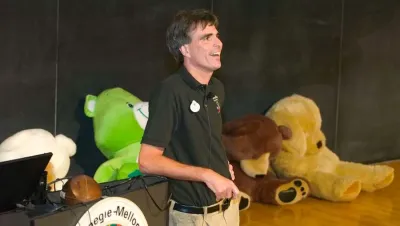CMU Releases Remastered 'Last Lecture'

Using AI, a video systems engineer who worked with Randy Pausch revisited inspirational talk viewed by millions worldwide
Brian Parker has filmed presidential visits, experimented with cutting-edge video technologies and orchestrated dozens of large-scale productions during Commencement and Orientation over a 27-year career at Carnegie Mellon University.
Yet no other production has had the lasting impact of Parker’s work with the late Randy Pausch, which was seen by millions around the world. Using AI tools, Parker has meticulously created a remastered version of “The Last Lecture,” which he filmed 17 years ago on Sept. 18, 2007.
The heartening talk wasn’t Parker’s first collaboration with Pausch, a computer science professor and co-founder of the Entertainment Technology Center, a groundbreaking graduate program that combines arts and computer science at Carnegie Mellon. They began working together years prior, recording Pausch’s Building Virtual Worlds exhibitions from 1999-2007.
“Randy loved our work. He asked me, three days prior to giving ‘The Last Lecture’ to ‘record a nice, high-quality heirloom’ for his kids. But he wasn’t telling anyone in the audience. I had to keep it all secret,” said Parker, a video systems engineer in CMU’s Media Services.
The remastered video is embedded above.
Keeping Pausch's lecture secret
Due to the secrecy, Parker planned out a large-scale style production with a skeleton crew: one lighting designer and one camera operator. Parker operated two robotic cameras while simultaneously directing.
“Randy knew what he wanted. He knew how to make things exciting, and that made me feel like it was something I wanted to do,” Parker said. “He would generate so much excitement for anything he did that it’d be standing room-only in McConomy Auditorium. For his Last Lecture, there was a line around the block waiting to get in.”
In place two hours early, Parker watched the room fill to capacity with rows of people sitting in the stairwells. What happened next would touch more hearts and minds than could fill McConomy a thousand times. Pausch’s talk about achieving childhood dreams was a lesson to his children about overcoming obstacles, seizing life’s moments and living generously while supporting the dreams of others.
Pausch's words inspire millions worldwide
Parker truly understood the reach of Pausch’s message when Diane Sawyer encouraged the audience of “Good Morning America” to watch the video, sending tens of thousands of people to view it.
The video soon became one of the first videos uploaded to Carnegie Mellon’s YouTube channel, amassing more than 21 million views since.
“Then Randy’s life got super busy. The only time after that we talked is when he personally brought me a signed copy of his book,” Parker said.
After the talk, Pausch appeared on Oprah, joined the Pittsburgh Steelers for a day of practice, and went on to co-author a New York Times bestselling book adaptation of “The Last Lecture” with Jeffrey Zaslow, which has been translated and sold in dozens of languages worldwide.
Pausch died on July 25, 2008. On Carnegie Mellon University’s campus, the Randy Pausch Memorial Bridge connects the Gates Center for Computer Science and the Purnell Center for the Arts, a visual reminder and memorial of his work to bridge the arts and computer science.
How AI helped enhance old tape
With recent developments in AI video editing technology, Parker thought “The Last Lecture” was the right project to update. Parker ran 15 seconds of footage through new software and found a stark difference in detail.
“It was footage of Randy on stage, some slide material and some medium-dark shots of someone sitting in the audience. There was a striking difference, to where you could see detail in his hair. You could read the Walt Disney insignia on his shirt. Even the soda bottle on the back wall, you could see the kind of drink he was drinking,” Parker said.
Now planning to revitalize the entire production, Parker needed to recapture the recording in the highest quality possible — from the original DVCAM tape, a format no longer widely used. Parker tracked down a working player and MacPro tower from 2008 capable of capturing and converting the footage into a high-resolution ProRes format.
“When you get nice, clean pixels, the AI software really shines,” Parker said.
After making additional enhancements, including color and brightness adjustments and logo updates, Parker exported the new, remastered file, a process that took 4 1/2 hours to complete.
“I remember filming it and thinking, finally! Everyone knows. I kept it a secret for three days!” Parker said. “It touched so many people. Last year at a video conference, I met people in the broadcast industry who knew about Carnegie Mellon because of Randy Pausch. They asked me if I knew about ‘The Last Lecture.’
“Do I? I could tell you a story about it.”
Original post from Carnegie Mellon News
Brian Parker delivers a talk at Carnegie Mellon on generative AI in media.

